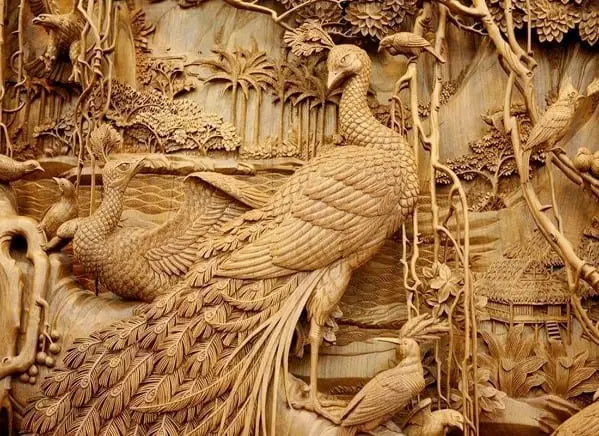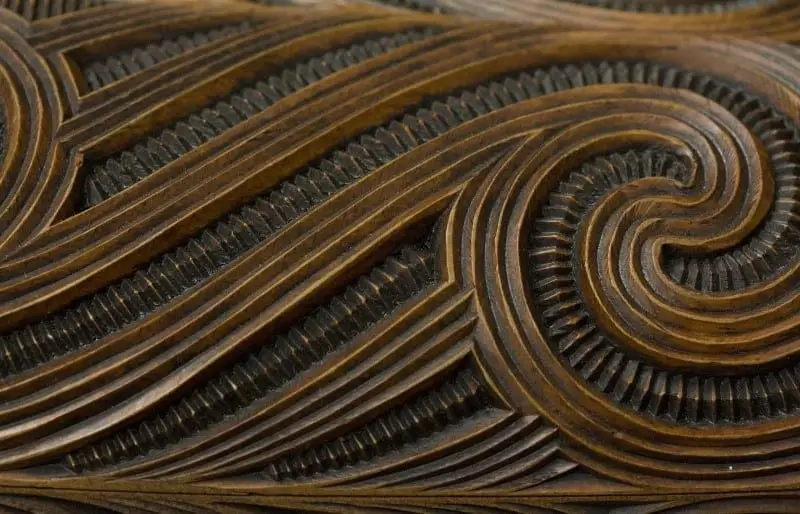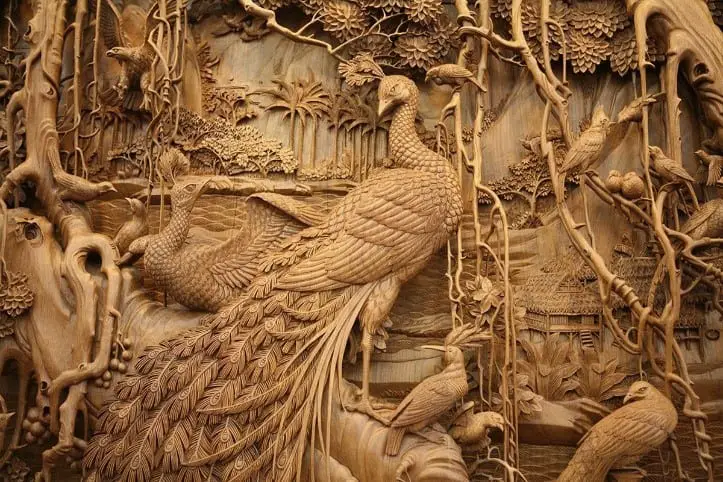
Magnificent examples of work of wood in Saharanpur, India – Image Source
“India is the cradle of the human race, the birthplace of human speech, the mother of history, the grandmother of legend, and the great-grandmother of tradition. Our most valuable and most instructive materials in the history of man are treasured up in India only.”
Mark Twain
And indeed, the cultural inheritance of India has heavily influenced the rest of the world, and this doesn’t refer only to the art of woodworking.
Nevertheless, what Steve Jobs shares about his trip to India is no less intriguing than Mark Twain’s impressions of the country.
“Coming back to America was, for me, much more of a cultural shock than going to India. The people in the Indian countryside don’t use their intellect as we do, they use their intuition instead, and their intuition is far more developed than in the rest of the world.”
Steve Jobs
Do you want to learn more about the art of working with wood in India? Read on and indulge in the wisdom of the natives.
Admiring the Beauty of Ancient Wood Carving in India: Lokanarkavu Temple

Poorakkali – a rare form of folk dance performed annually at the Lokankarvu Temple festival – the Mandala Utsvam – Image Source
For a start, Lokanarkavu Temple is located in the coastal town of Vatakara (also pronounced as Vadakara), in the Kozhikode district, which is part of the state of Kerala.
Interestingly, Lokankarvu Temple is complexly structured. Thus, it includes the temple of Goddess Bhadrakaali, the Temple of Lord Vishnu, as well as the Temple of Lord Shiva.
What’s more, experts have evaluated that the wooden sculptures and carvings in the Temple of Lord Shiva are over 300 years old.
However, due to both time and age, many of the incredible carvings, as well as murals found in the temples were exposed to deterioration.
Fortunately, in 2017 a special program was started in order to restore and preserve the artifacts in the Lokankarvu Temple. Valsan Achari who comes from a family of carpenters was put in charge of the restoration program, as he has specialized temple architecture.
The intricate wood carvings and sculptures in the temple tell legends straight from the very heart of the Indian beliefs. For instance, the sculpture at the very center of the ceiling represents the so-called Navagraha. Navagraha translates into “nine planets.”
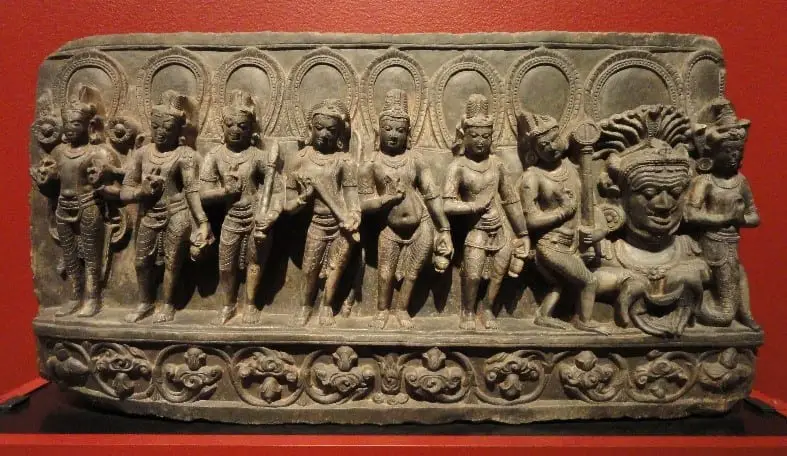
Navagraha sculpture dating back to the 10th century AD, currently exhibited at the San Diego Museum of Art – Image Source
According to Indian mythology, these 9 planets also symbolize mythical deities, and not solely astronomical bodies. Alongside the Navagraha sculptures, there are 4 wooden panels which feature other types of ancient designs.
Firstly, 2 of the wooden panels include Mrugamala and Pakshimala. Mrugamala designs evolve around the depiction of animals, and predominantly elephants. On the other hand, Pakshimala designs evolve around the depiction of birds.
Next, the rest 2 wooden panels depict various scenes from human life, including erotic scenes, too. These type of sculptures are called Bhoothamaala.
Video by Dsource Ekalpa India – Wood Carving for Temples – Kasargod, Kerala
Source: youtube.com
What Types of Wood Are Used by the Local Craftsmen in India?
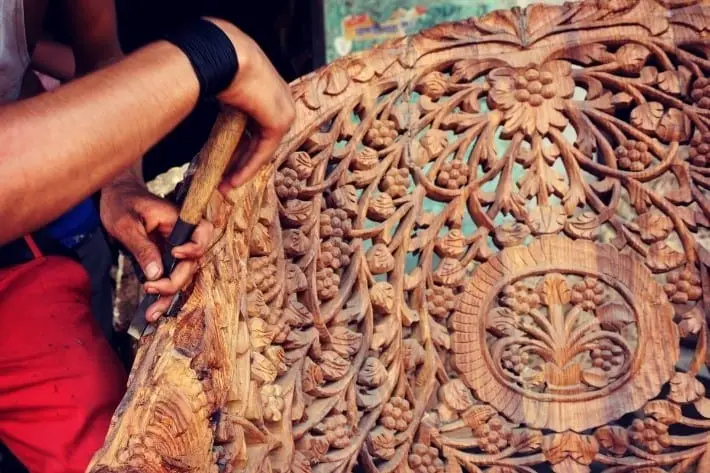
Walnut wood carving in Kashmir, India – Image Source
Above all, some of the endemic tree species of India are truly one-of-a-kind. For example, the superb quality walnut wood which is typically used in the art of wood carving in Kashmir is obtained from a local walnut tree known as “Doon Kul.”
But what makes Doon Kul so special?
- Doon Kul is cut only once the tree has matured to the stunning age of 300 years
- Doon Kil is available only in the district of Kashmir, India
- Doon Kul is both durable and hard
- Doon Kul is close grain, which makes up for very fine and intricately detailed carving due to the unique silky texture
Interestingly, the master artisan of Indian wood-carving – Khalid Mohd – who has over 55 years of experience points out to the fact that the most expensive part of the Doon Kul tree is the root.
And indeed, the wood from the root differs in color from the trunk and branches, as it is much darker. In short, it is the darkest parts of the Doon Kul which are considered to be the strongest, and also possessing a grain which is better pronounced than that of the trunk and branches.
However, Indian craftsmen do work with the entire wood obtained from Doon Kul, even though the root is labeled as the most valuable of the whole.
When it comes to the history and traditions of woodcarving in the notorious artisan district of Kashmir, the experts believe that walnut wood carving, in particular, was first introduced in the 15th century by the Islamic missionary Sheikh Hamza Makhdoom.

A local artisan in the process of walnut wood carving in Kashmir – Image Source
Another amazing type of local wood that the Indians use in the art of wood carving is sandalwood.
Specifically, masterpieces made out of sandalwood have become a trademark of the state of Karnataka. Not only is sandalwood abundant in the region. What’s more, it adds an exquisite charm to all things woodworking related, due to its distinct aroma.
Video by Dsource Ekalpa India – Sandalwood Carving – Sagara
Source: youtube.com
Styles of Wood Carving in India
For a start, it’s important to mention that woodworking in India has been rapidly developing throughout the course of the last decade. Thus, nowadays, not all wooden objects originating from India are made exclusively by hand.
However, the ancient traditions of working with wood have been preserved well by the master wood carvers who continue the crafts of their ancestors.
To summarize, there are 5 main styles of wood carving in India.
1) Jalidahr (Open work)
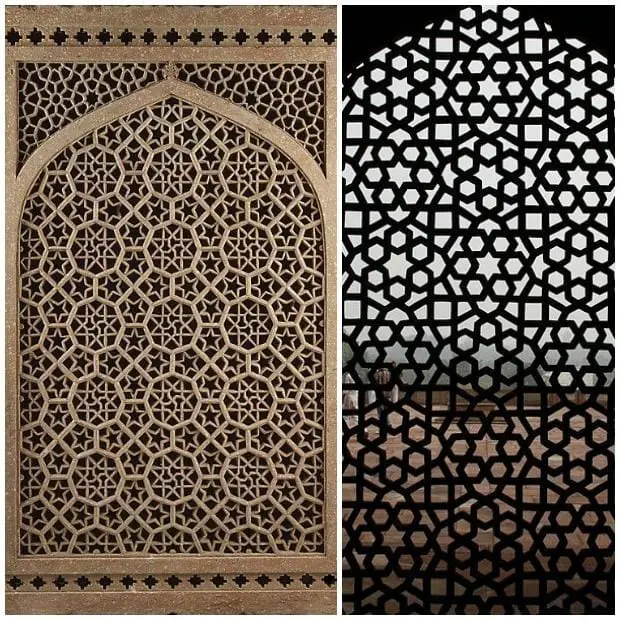
This style is referred to as “open” because it allows the contemplators to see-through thanks to working in screens. Examples of this particular style include the Mogul jail patterns, among others.
2) Sadikaam (Shallow work)
Just like the name suggests,the patterns of this particular style appear as if only chased along the lines with a pencil, lacking depth but attaining exquisite delicacy.
3) Vaboraveth (Deep work)
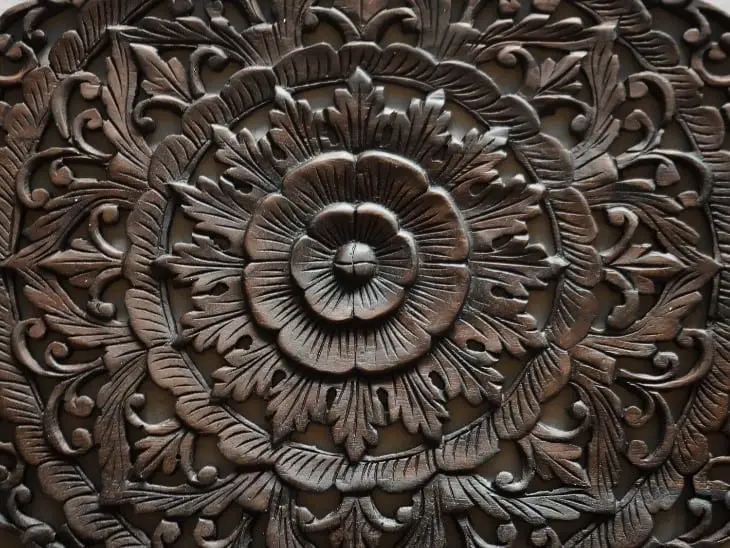
In this wood carving technique, the depth of the work can reach up to 5 inches. Thus, Vaboraveth is also known as “raised work,” and is widely used in the depiction of lotus flowers and dragons.
4) Padri (Semi deep work)
Typically, the Padri style encompasses a central motif, which is framed with thin panels along the very rim of the surface.
5) Khokerdar (Undercut work)

Khokerdar is one of the most captivating styles because it aims to create a 3-dimensional depiction of various patterns and scenes, which can also appear to be in motion, such as flying birds, for example. Also, this style compromises of multi-layers, which can reach up to 7 in total.
21st Century Woodworking: Incredible Stories from India’s Beating Heart
Our society is reaching a peak in the way globalization affects the environment. With this in mind, much has been said about the significance of recycling and upcycling. However, not all of the nations throughout the globe are putting enough efforts into making sure that all the materials they use are sustainable.
But here is where the brilliant example of recycling wood in India kicks in.
Video by gurjarvani – Wooden Wonder – Recycling wood in Ahmedabad, India
Source: youtube.com
Interestingly, the people who take part in the recycling process belong to the poorer sections of society.
Thus, we can conclude that the desire of each nation to work in favor of the humankind throughout the globe isn’t limited to those who are lucky to possess more than enough.
Instead, the key to understanding our responsibility towards Mother Nature and Planet Earth is intricately connected with our most sacred beliefs. With this in mind, the Indians stay true to being highly spiritual.
What’s more, experts state that Hinduism is probably one of the most concerned religions on the planet when it comes to the relationship between the environment and humanity.
For example, Krishna compared the world with the banyan tree. That’s because of the way the fact the banyan tree is so large that it can provide a home for many different creatures, just like the world provides enough food, air, and shelter for all the people.
Thus, Indians are restlessly looking for ways to help the planet cope with the deep issues caused by human negligence towards the surrounding environment. For example, an Indian company managed to build a zero-energy air conditioner which uses only clay pipes and water to cool the air.
Amazingly, the development of the art of woodworking and woodcarving in India seems to know no limits.
Contemporary wood virtuosos such as Bhuvanesh Gowda who was born in 1976 keep pushing the boundaries of the ancient crafts related to the culture of wood. Not only does he merge the traditional Indian styles with those of Eastern philosophy and new developments in quantum physics.
On top of that, he chooses to work with salvaged wood which is either purchased as second-hand or sent by friends.
“The use of salvaged wood lies in my responsibility towards the environment as a human,”
Bhuvanesh Gowda humbly explains.
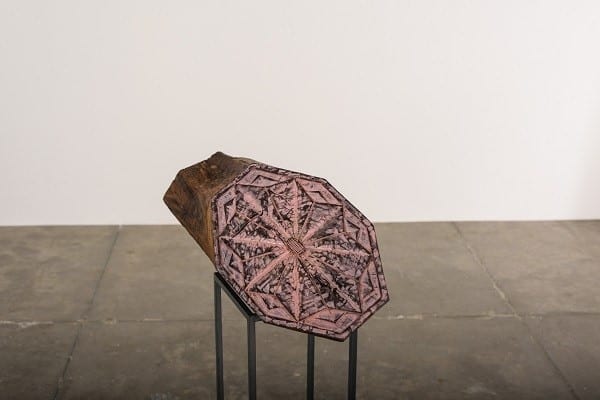
Artwork by Bhuvanesh Gowda – Image Source
The Bottom Line

In his beautiful novel Shantaram which was published back in 2013, Gregory David Robertson shares the following insight about the way Indians live and love:
“Indians are the Italians of Asia and vice versa. Every man in both countries is a singer when he is happy, and every woman is a dancer when she walks to the shop at the corner. For them, food is the music inside the body and music is the food inside the heart. Amore or Pyar makes every man a poet, a princess of peasant girl if only for second eyes of man and woman meets.”
Gregory David Robertson
Whether it comes to the way people in India reflect upon their responsibility towards the environment, or whether it comes to working with wood, the culture of the native people points out to a single truth: that we are all children of the Universe, with no regards to gender, race, religion, or age.
